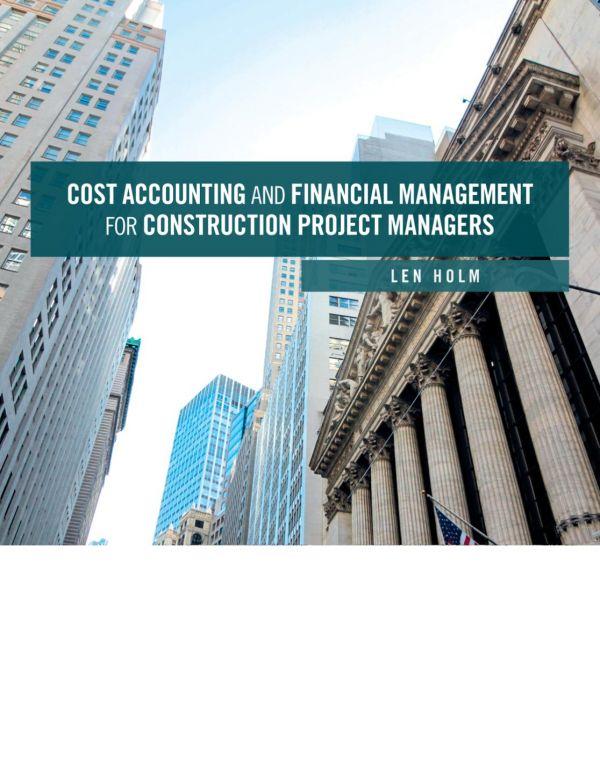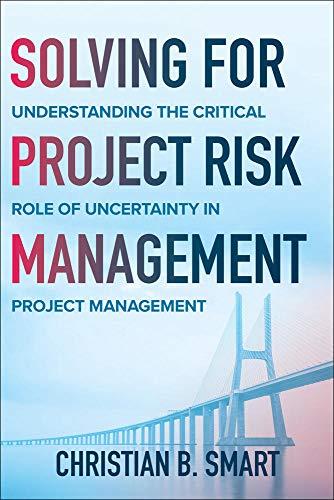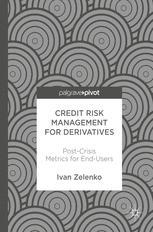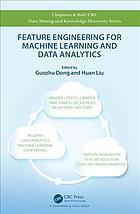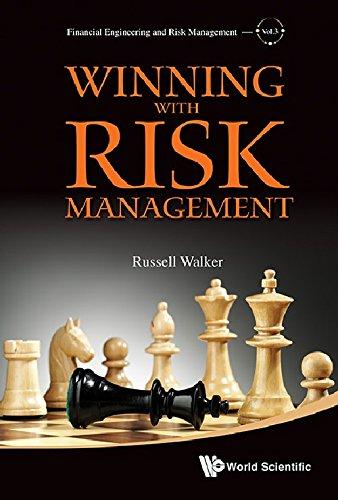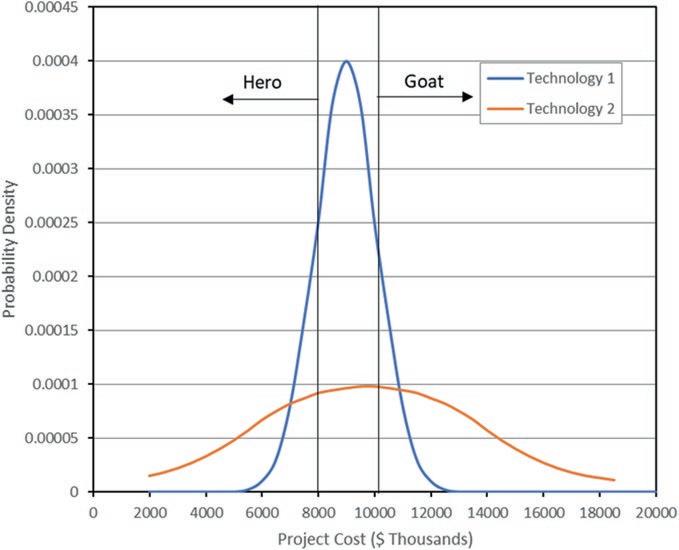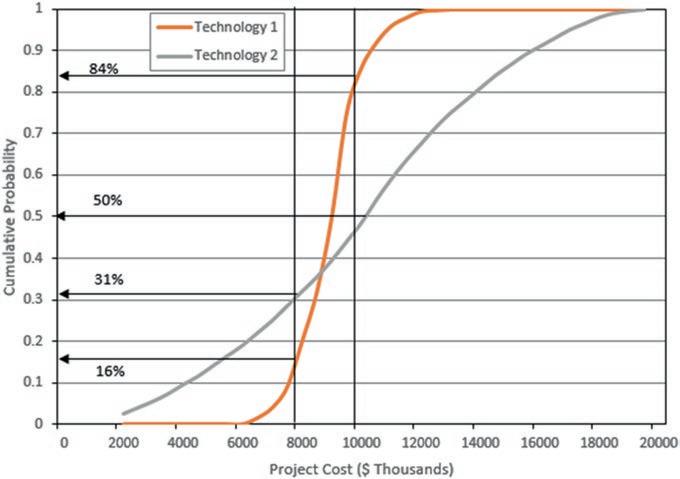Uncertainty
Aleatory uncertainty is measured or characterized by relative frequencies: the number of times a particular event occurs out of N repeated experiments. In gambling, for example, with dice, there is complete knowledge about the potential states to be encountered (in a modern die, the integers 1–6, and with two dice, the integers 2–12). This type of uncertainty is objective, it is a characteristic of the real world, and it can be measured, at least approximately. This type of uncertainty is the business of statisticians. It is external to and independent of the observer; e.g., a
radioactive cesium atom is presumed to decay with a certain probability whether or not anyone observes it. Presumably any number of experimenters or observers of identical experiments would observe the same relative frequencies in the long run. The relative frequencies, either derived from observations or from deductive principles, are then called probabilities. A probability is a relative frequency taken to the limit. For example, let the relative frequency of some event j be given by the ratio fj = nj/N, in which nj is the number of observations of event j and N is the total number of observations. Then the probability of event j is pf nN j N
But we can never do an infinite number of observations, so these relative frequencies or probabilities are actually based on the outcomes of experiments that are never run. Or, in observing a die, we may say the probability of each side coming up is (or, rather, should ideally be) 1/6 without making any observations of the actual relative frequencies; this set of probabilities (the probability distribution) is assumed to be characteristic of some ideal die, even if may be a poor assumption for any die you happen to be betting on.
We may subdivide this classification of aleatory uncertainty in the following subtypes.
Type 1, in which we know the form of the probability distribution and the parameters of the probability distribution. For example, we say the probability distribution for the flip of a fair coin is the binomial distribution, and the probability of obtaining a head on one flip is 1/2. Similarly for the six-sided die: the probability for each side is said to be equal, and lacking any better information, equality implies the probability of each is 1/6. This is the type of probability commonly covered in probability courses and with which most people are familiar.
Type 2, in which the form of the probability distribution is known (or believed to be known based on some theory), but the parameters are unknown. This might be the case with a coin that may have been tampered with, or a pair of dice that we may have suspicions about. There is no question about the form of the probability distribution, but determining the actual values of the parameters (in the case of the dice, the actual relative frequencies of getting each of the 11 outcomes) is a point at issue.
Type 3, in which the parameters (relative frequencies) are known (through observations) but the form of the probability distribution is unknown. This often occurs when one has a lot of data, including relative frequencies of various events, but has no theory to tie them together. Here the reasoning is inductive: given these observations, what probability function best describes the data? We may either fit some probability distribution to the data, or else use the observed relative frequencies themselves as the empirical probability distribution.
Type 4, in which neither the form of the probability distribution nor any values for the parameters are known. Hence, if the form is not known, even the identity of the parameters is not known. Our job, then, may be to determine both the form of the distribution and its parameters simultaneously.
1.1.2 Epistemic Uncertainty
Epistemic uncertainty is the uncertainty that does not derive from variability in repeated experiments. It arises because of our limitations; reality is thought to be deterministic but we cannot see or know the true reality, only shadows of it. Pushed to the limit, this position would say that the future could be predicted without error if we only had enough information. For example, from this viewpoint, the classical gambling problem that motivated the development of probability theory could finally be solved: the outcome of shooting dice would not be random, because, given knowledge of the initial positions and orientations of the dice, and all the forces acting on them during the roll, one could predict with certainty how the dice would come up. Thus, we use the roll of dice as a standard for randomness simply because we cannot (the casino won’t let us) or do not choose to make all these measurements and computations. If we could, of course, no one would ever again shoot dice.
Epistemic uncertainty is not based on relative frequencies, as the “experiments” of interest are not repeated, and an event may happen only once or not at all. As such, it is the business of managers and engineers. Although some people object to the use of subjective probabilities, the issue in practice typically is whether to use subjective probabilities or no probabilities at all; that is, to stay with deterministic analysis (which is equivalent to probabilistic analysis with all probabilities either zero or one). One may adopt the viewpoint that we would use relative frequencies if we had any data, but as typically we do not, and as managers we must nevertheless make decisions, we may have use subjective probabilities as better than nothing.
1.1.3 Agnostic Uncertainty
Agnostic uncertainty is about our confidence and completeness of knowledge and assumptions upon which we develop probabilities and judgments. In a strict sense it cover both frequentist and epistemic viewpoints as they both are associated assumptions. We may further subdivide agnostic uncertainty in the following subtypes.
Volitional uncertainty is a type of uncertainty in the area of projects, in which the subjective probability distributions are not objective or “out there,” but are capable of being manipulated by the very people who develop them and use them. (Volitional derives from the Latin uolo, I wish for something, want something, or choose something with free will – cf. uoluntarie, of one’s own accord.). This uncertainty does not derive from that fact that we may not know the probabilities on the roulette wheel the casino is using, but from the possibility that the casino may be consciously capable of affecting these probabilities in its favor, based on the distribution of bets. This may sound like a nonscientific position, but people and institutions often modify their behavior based on what they perceive to be (or are told to be) probabilities of various outcomes, and these changes in behavior in turn change
the probabilities. Therefore, the problem of predicting behavior under uncertainty is not one of linear extrapolation; it involves nonlinear feedback loops, psychology, and game theory.
Suppose you were asked to give the probability that you will spend this evening doing homework, as opposed to going to the movies, watching TV, or playing poker. You may give the odds for each, but these are not odds that someone else would care to bet on, as the actual outcome depends entirely on your volition. Someone placing a bet on what you will do this evening would have to consider your psychological state, peer pressure (to play poker), and whether you stand to profit from the bet.
As another example, suppose that a contractor is informed by an objective, unbiased risk analyst that the probability that the contractor will overrun his schedule and thereby forfeit a substantial incentive payment is 50%. We may expect that this contractor will take whatever steps he can to change this probability. In fact, the amount that this probability changes due to contractor actions may depend on the amount of the incentive payment relative to the costs to the contractor of getting earlier completion. We would expect the contractor to be able to change this probability by any of a number of actions, until the probability of overrunning is much less than 50%, but if he/she had not been informed of the 50% probability of overrunning, he might have taken no action, and the 50% would have continued to be true. Conversely, if the contractor had been informed that the probability of overrunning on this job was 1%, the contractor would probably place his attention and resources on other jobs, and the probability of overrunning might increase as a result.
Under such conditions, what does the term “probability” mean? It certainly has nothing to do with relative frequency. This job will ultimately finish; the contractor will get incentive payment or won’t; there will be no repetitions of this experiment from which to gather statistics.
A true probabilist might argue that the apparent issue arises because the problem is miss-specified. What was called a probability is really a conditional probability; the quoted 50% probability is really a value that is conditional on everything remaining the same, that is, the contractor taking no action, or being unaware of the probability statement. There are then multiple conditional probability distributions, for the probability of overrunning conditional on the contractor taking no action, some action, moderate action, a lot of action, etc. That is, volitional risk is not a property of an event or a project, but rather is something that can be mitigated or managed through actions of people. Thus, if X is some risk event, we may characterize the uncertainty about whether the event X will occur in one of the following ways:
• There is an aleatory probability P[X] that is characteristic of X and that can be estimated objectively from the relative frequency of past occurrences of X.
• There is an epistemic or subjective probability P[X] that reflects the observer’s degree of belief that X will occur, whether or not X has ever occurred in the past.
• There are volitional risks P[X|no mitigation], P[X|mitigation of type 1], P[X|mitigation of type n] etc., depending on what somebody chooses to do after obtaining some information about P[X].
Agonistic uncertainty (from the Greek αγοv, a contest or struggle), derives from the competitive nature of projects. A contractor’s profit on a project is at risk not only due to uncertainties regarding quantities, prices, performance, etc., but also due to the competitive nature of award of projects and the competition or cooperation during the project with clients, subcontractors, suppliers, regulators, etc. This form of risk is not typically covered by texts on risk analysis (which deal largely with aleatory uncertainty), but is significant for projects. Contrary to some belief, a contractor’s price on a job is not determined by some percentage markup over the estimated project costs, it is determined by the number of competitors making bids and how much they need the business. The theory of competitive and cooperative games can contribute to understanding these risks by examining what the various actors or players in a project will do if they act so as to maximize their own utility. For example, a solution to the interactions of all the actors on a project is a stable equilibrium if all players play their best strategies and no player has any incentive to unilaterally deviate from the equilibrium position.
Dialectic uncertainty (from the Greek διαλεκτική, a discourse of investigation, development through the stages of thesis, antithesis, and synthesis in accordance with the laws of dialectics e.g. transiency and tipping points, contradictions, negations). Dialectical uncertainty summarizes all dogmatism and narrowness of thought about process dynamics and transformation for which we seek warnings. For example, previous data and even the current observations on a project may imply arrival of rework items at a stable trend. However, how stable is this trend? Will the project come to a tipping point when suddenly the number of rework items increase exponentially and the completion rate reverses to negative? Being blindsided by apparent stability in observed data and the effect of dynamical transitions with “longer amplitudes” can be best summarized by a prologue from a film La Haine by an acclaimed French director Mathieu Kassovitz: “…Heard about the guy who fell off a skyscraper? On his way down past each floor, he kept saying to reassure himself: So far so good… so far so good… so far so good…”.
One could, perhaps, continue this process of defining agnostic uncertainty as it relates to our ignorance: i.e. uncertainty as it relates to complex coupling of projects and work packages, nonlinearities human responses to work load requirements, etc. However, this is not the objective of the text, nor the intention of this section. What we here try to illustrate is that uncertainty is more than just frequentist or epistemic definition of the underlying behavior, it involves confidence and completeness of underlying knowledge, scientific theories, assumptions, and dogmas that constitute the basis upon which we quantify and express the uncertainty, regardless of the two approaches. This takes us outside of the comfortable position of defining and quantifying uncertainty from probabilistic viewpoint into a domain where some measures are required to express confidence and completeness of knowledge, underlying scientific theories and assumptions. Recent advances in risk analysis focus on expressing these in measurable quantities and detectable events (i.e. strength of knowledge, assumption-based planning, early warnings signs), or indices and metrics that could provide an implicit indication of the level of ignorance upon which the risk assessment was based (i.e. risk network measures, project leading indicators) In fact, project managers have historically relied on indices to weigh the level
of overall project risk. For example, rather than relying solely on the experts’ judgement of scope increase probabilities, project managers would use scope definition indices such as Project Definition Rating Index (PDRI) to provide a leading indicator of future risks or to reflect the overall level of uncertainty.
This is not implying that probabilistic methods are outdated or feeble, but that more complete definition of uncertainty should be considered when risks are assessed and managed. In fact, this text is all about applying probabilistic methods to the assessment of project risks, on the basis that probability theory has a long history of development and an existing calculus allows us to deal with uncertainties. Moreover, many people are at least familiar with fundamental probabilistic concepts through courses in probability and statistics, although this familiarity may be an impediment to making the transition from probabilities as relative frequencies to probabilities as expressions of subjective belief. Rather than invent a new calculus, one can adopt the calculus of probabilities to applications in project risk assessment. For example, we will wish to ask questions such as, How can risks be quantified and compared (one risk is greater than another)? How can risks be considered objective and independent of the observer? How can risks be combined or added? How can risk assessments by different observers be combined? How can risks be allocated and compared to rewards? How much risk should one take on? How much contingency (safety margin) should one keep in reserve? All these questions, and many more, are addressed by classical probabilistic methods. The answers probability gives may not always be right (and who could tell?) but are better than no answers at all. That is, any computations regarding probabilities should be taken not as descriptions of physical reality but in conjunction with the assessment of underlying knowledge and assumptions as a guide or a support to management decisions and actions.
1.2 Representation of Uncertainty
On the fundamental level, we represent uncertainty in terms of outcome probabilities. In the frequentist interpretation this probability reflects the occurrence of the event in the study/experiment. Clearly some problems, conceptual as well as computational, arise when one departs from the comfortable territory of probabilities as relative frequencies of physical events to probabilities as degrees of belief in some future outcome, conditional on acts of some decision makers. Is it possible to use probability theory, which after all was originally invented to describe how one might win at gambling tables (that is, aleatory uncertainty)? In fact, there are other approaches than the relative frequency approach, including the following: Bayesian methods, which use probabilities but regard the parameters of probability distributions as random variables in themselves (not acceptable to a classical relative-frequentist) that are re-estimated whenever new data appear (Gelman et al. 2013). Bayesian methods are discussed later, in a number of different contexts.
Theory of Evidence and Dempster-Shafer Theory, which deal with degrees of belief and how to change them based on new evidence (Dempster 1976; Pearl 2014). Thus, when the hypothetical unbiased observer says that the probability of overrunning is 50%, what he means is that his degree of belief that the project will overrun, based on observed conditions, past history, and other factors, is about midway between no chance at all and dead certainty. This degree of belief may well change if the contractor takes some action that changes the observer’s belief in the outcome. We might then inquire, what actions could the contractor take that most cost-effectively change the observer’s degree of belief that the project will overrun? If there is more than one observer, with different degrees of belief, how can they be combined into one? Or should they be?
Fuzzy Sets, which assign quantitative values (membership functions) to linguistic terms, such as “risky.” Fuzzy sets are super sets of classical set theory or Boolean logic, in which a proposition is either true or false (1 or 0). In fuzzy set theory and fuzzy logic, propositions may take on any values in the interval from 0 to 1. Therefore, fuzzy set theory is said to be more general than classical set theory, although Boolean logic is general enough to power all digital (really, binary) computers (Klir and Yuan 1995). Subjective or Bayesian probabilities do not derive from classical set theory, but rather are a part of the mathematical field of measure theory. Therefore, fuzzy sets and subjective probabilities are two completely different, incommensurate ways of dealing with uncertainty. A simplified example of the difference is the following. When categorizing some object, in fuzzy set theory the parameters of the object are known with perfect certainty, but classification is difficult because the boundaries of the classes (sets) are vague or ambiguous (i.e., fuzzy), due to the limitations (ambiguity, lack of precision) of language. In the probabilistic approach, the boundaries of the classes are known with perfect precision, but classification is difficult because the values of the parameters (measurements) are uncertain.
In addition to the above-mentioned, there are many other theories and methods to represent uncertainty in decision process including possibility theory, interval probabilities, entropy, ambiguity, and info-gap theory. In attempt to obtain more realistic representation of uncertainty in the system behavior, researchers and scientist will continue to look for new methods.
1.2.1 Process Variability
Project outcomes and data can also be analyzed probabilistically from a time-series perspective. In fact, this text also examines the dichotomy of uncertainty suggested by the methods of Statistical Quality Control (SQC), Statistical Process Control (SPC), and, most recently, Six-Sigma. Here, adopting the viewpoint of Statistical Process Control, we make a distinction between processes (that is, project time series) that are in control and those that are out of control.
Stating that a process is in statistical control does not mean that it doesn’t vary, or that is completely deterministic. Rather, this term recognizes that there are uncertainties or variability in the process, due to the action of common causes, but the process stays within the limits of this variability. This variability or uncertainty is inherent to the nature of the process (Thompson and Koronaki 2002). As long as the variability in the process stays within bounds, the process is said to be under control. In the language of statistical quality control or Six-Sigma, σ is the natural or inherent standard deviation of the variability of the process, and as long as the output of the process is randomly variable but remains within the bounds defined by the mean plus or minus 3σ, it is considered to be in control.
However, the fact that a project or process is in statistical control does not mean that it is acceptable. The natural variability may be larger than we can tolerate. The outputs may be in control, but they may not meet our requirements. In this case, the process as defined is not capable of producing acceptable work. For example, suppose that we are concerned with the total cost (or duration) of a project. Each work package in the project has some expected cost, and also some uncertainty or variability due to the nature of the work, local conditions, etc. However, it may happen that, when one examines the variability or uncertainty in the total project cost, which is in some sense the sum of the cost uncertainties in all the work packages, the likelihood of exceeding the project budget is unacceptably large. The solution to this problem is to change the process. Some or many of the work packages may have to have their work processes changed in order to reduce the expected cost or the variability (uncertainty) in the costs to an acceptable level.
Conversely, a project or process may go out of control due to some extraordinary external or internal cause. The solution to this problem, if it occurs, is to track down the cause and eliminate it. A better solution is to identify such causes before they happen and take steps to assure that they don’t happen, or that their impact is much reduced. This is the objective of risk analysis and mitigation.
In this text, the first kind of uncertainty is that associated with the natural variability of processes, even those under control. Incremental risks include risks that are not major in themselves but can accumulate to constitute a major risk. For example, a cost overrun in one subcontract may not in itself constitute a risk to the project budget, but if a number of subcontracts overrun simultaneously, due to coincidence or to some common cause, then there may be a serious risk to the project budget. Individually, such risks may not be major or difficult to identify; the risk really lies in the combination of a number of them, and the lack of recognition that these could occur simultaneously. These incremental risks are typically analyzed using probability distributions, in the form of either probability density functions or probability mass functions. Often we use probability distributions because they can represent our lack of information or state of ignorance by relatively few parameters (usually two or three), and who wants to have to specify a lot of parameters to express one’s ignorance? In this case, the variability in each activity or process is considered to be incremental or differential; it is the combination of all the activities that is of concern.
In the second case, attention is focused on specific, discrete events that are uncertain in that they may or may not occur. These catastrophic risks include risks that could be major threats to the project performance, cost, or schedule. Such risks might include dependence on critical technologies that might or might not prove to work, scale-up of bench-level technologies to full-scale operations, discovery of waste products or contamination not expected or not adequately characterized, dependence on single suppliers or sources of critical equipment, etc. These risks are typically discrete events, and must be individually managed. This is the area usually considered to be risk mitigation or risk management, but in fact both these cases require management. In the first case, the project manager must identify the control limits and design and manage the project execution process such that it stays within the required limits relative to time, cost, and quality. In the second case, he/she identifies and manages discrete risks.
Further, there are situations when variations and changes in trend are due to transitions in internal behavior, rather than external risk; projects, in fact, often experience changes in trend over time and exhibit non-stationarities and tipping points. This dynamic nature of uncertain systems’ behavior can be represented using stochastic/probabilistic processes. However, as this is rather a very broad area of probability theory, for practical purposes, we limit the scope of this text to time-series, process control, and few fundamental processes such as Poisson process.
1.2.2 Probabilities and Decisions
Uncertainty assessment and risk analysis are generally done for the purpose of making risk-informed decisions. Hence, it is upon the decision-maker to interpret the result of the analysis. Figure 1.1 illustrates this process. The two typical paths are illustrated with a blue and orange colored lines; the former shows when system/ project data is available (blue line – frequentist approach), and the latter shows when the data is not readily available and when the experts’ judgements are required (orange line – epistemic approach). In both cases the probability estimates are based on the analyst’s assumptions. However, there is a path, illustrated with a maroon colored line, that doesn’t involve the same level of assumptions. It feeds processed data about the system directly to the decision-maker. This type of data is representative of the system behavior, but not expressed in terms of outcome probabilities. There are two reasons why one may want to consult other-than probability measures when making decisions. First, probabilities are sometimes hard to interpret and/or can be misleading; for example, one may be tempted to replace flight data with the cockpit indicator that reports the results of a risk analysis for a stall probability. However, from the pilot’s perspective (i.e. decision-maker), this information would be counterproductive as flight data i.e. the position of an aircraft and speed are much informative and easier to map into decisions than the estimates of the event probabilities. How much one should be one worried if this probability is 1%? Would 50% probability warrant an immediate mitigation decision? Pilots regularly make maneuvers that significantly increase this probability, yet they are

in full control. This doesn’t imply that providing such probabilities is wrong; in fact all commercial aircrafts have a similar feature i.e. an alarm, but it stresses the fact that proper decisions cannot be made in isolation of system-level data. Second, by relying only on probability measures one allows for convolution of assumptions. For example, we regularly make decisions about distribution type, sample independence, and stability of the underlying process that has generated the data. Similarly, subject-matter experts assign probability based on their experience about the systems behavior but based on many conscious and subconscious assumptions and biases (Damnjanovic and Aven 2018). The bottom line is – How valid are these assumptions?
To overcome this issue project managers supplement the probability measures with indicators developed using system-level data that have no, or only few embedded assumptions. Here the system feature is used as an implicit indicator of outcome probabilities; this is similar, or perhaps the same as leading indicators. For example, task completion times are highly sensitive to resource availability; if the tasks share common resources, then such set up is more risky from the perspective of completion time, as any event affect the common resource will be propagated to all tasks. Hence, having a measure of resource-task dependences is informative about the risk, but not defined in terms of probabilities. Similarly, as mentioned before, project managers often use scope index to assess potential risks with scope creep, and feedback loops in design to reflect design rework risk. Some may refer to these as explanatory variables in a propensity function. But then again, this would imply adding assumptions such as type of the function, which is precisely what we try to avoid.
Fig. 1.1 Uncertainty and risk assessment decision process
1.3 Is Uncertainty Always Bad?
In general, most people prefer less uncertainty to more uncertainty. In fact, they may take many actions to buffer or protect themselves from uncertainties and their consequences. Also, risk is generally a pejorative term. Although there are people who like to take risks (e.g., skydivers), the intent is still to avoid the unpleasant consequences of the risk; if the risk actually happens (the parachute doesn’t open), it is generally considered bad.
However, in many cases uncertainty may mean opportunity. In fact, one may say there are no opportunities without uncertainties (if there were, someone would have found them already). Even Chinese language symbol for risk reflects its dual nature ; it encompasses a symbol reflecting danger and a symbol representing opportunity. Hence, if one wants to make a lot of money on Wall Street, one has to look at the stocks that are volatile (have large variability, called). However, this is also the way to lose a lot of money on Wall Street.
The judicious use of alternates or options may add value to projects even when (or especially when) these options have uncertainties (or risks). As an introductory example to what will follow, consider a manager on some project with the following conditions: if, after engineering is complete, the construction cost estimate less than $8,000K, then he is a hero; if it is more than $10,000K then he is the goat. Suppose that he will know the cost with sufficient certainty to make a go or no-go decision after the end of the detailed design phase. Suppose also that there are two alternate technologies. Technology 1 is conventional and straightforward, with an a priori (before the design phase) expected value of $9000K and a standard deviation of $1000K. Assuming these cost uncertainties are approximated by the well-known Normal probability distribution, then the project manager calculates that the probability of exceeding the maximum allotted budget if he chooses this design option is about 16%, which is not bad, but the probability that he will get positive recognition for coming in less than the lower target is also not better than 16%. See Figs. 1.2 and 1.3 for the probability density functions and the cumulative distribution functions.
Even though the probability distribution is symmetric, the project manager’s view of the outcomes is not necessarily symmetric. He/she may feel that being a hero is good, but the utility of being a hero is a lot less than the disutility of being a goat. That is, he may be risk averse.
The project manager also has available an alternate process, technology 2, with a higher a priori expected value of $10,000K and a much higher standard deviation of $4,000K. Technology 2 is not only expected to cost more than technology 1, it is far riskier. Using the Normal assumption, the project manager calculates the chances of overrunning the maximum budget with method 2 to be 50%. On the other hand, the chances of being a hero with this technology are 31%. Assume that the project manager has to make a decision on the technology before the design starts; he/she does not have enough time in the schedule to perform one design and then do the other if the first one does not come out satisfactorily. Probably under these conditions the project manager chooses technology 1; the chances of winning
Fig. 1.2 Probability density functions of project cost outcome
1.3 Cumulative probability distributions for project cost outcome
Fig.
big are small but so are the chances of losing big. Technology 2 has an attractive likelihood of doing very well, but too much chance of doing really badly.
However, the project manager might consider designing the project using both technologies concurrently, choosing the best one after the design phase has established the construction cost. In this case, the probability that the maximum budget of $10,000K would be exceeded is the likelihood that both technologies cost more than that (the project manager always chooses the lower of the two). Assuming that the technologies are independent (a higher than expected cost for one does not imply a higher than expected cost for the other), then the probability of exceeding the maximum budget is just the probability that both technologies result in higher than acceptable cost estimates. More personally, the probability that the project manager is a goat is the probability that technology 1 exceeds $10,000K and technology 2 exceeds $10,000K = (0.16)(0.50) = 0.08.
Conversely, the probability of beating the minimum target is the probability that either technology is less than $8000K, or 1 – the probability that both are greater than $8000K. This comes to [1.0 (1.0 0.16)(1.0 0.31)] = 0.42. That is, by designing using both technologies and then exercising the option to choose the one with the lower cost, the project manager reduces the chance of looking like a goat by one-half, from 16% to 8%, while at the same time increasing his chances of looking like a big hero from 16% to 42%. In probability notation, let x1 represent the construction cost using technology 1, and let x2 be the construction cost using technology 2. Then,
Of course, there is no free lunch; designing using both technologies will cost more than designing just one, and additional analysis would be needed to determine if it is worth it; here the point is that variability or uncertainty can be a good thing if it is used to create additional opportunities and decision options for the project manager.
So, is variability good or bad? It could be either. Generally speaking, variability is more valuable or more desirable if it is optional, or constitutes an alternative that can be used or taken advantage of by the project manager, and less desirable when it is inescapable. If technology 2 were the only option available, then the high variance of this alternative would be undesirable, but really makes little difference, because the probability of overrunning the maximum allowable cost is 1/2, regardless of the uncertainty in the cost of technology 2. However, the presence of technology 2 makes a high variability in technology 1 desirable. If the project manager decides to pursue both design options simultaneously, he can never do worse than the results with technology 1, and he might do a lot better with technology 2. Of course, real projects are not as simplistic as this example, but in any case it is up to the project manager to identify options that can make
variability an advantage and add value to this project. As in the old saw, if fate hands you a lemon, make lemonade.
1.4 Managerial Attitudes to Risk and Uncertainty
Project managers are concerned with ways to manage projects in the face of uncertainty, to analyze risks and to mitigate them. Projects continually face new risks, which must be identified, analyzed, and understood in order to develop a framework for selecting projects and successfully executing them. However, the term risk has different meanings to different people. For example, to economists and financial analysts risk and uncertainty are synonyms; the smaller the variations, the lower the risks. In engineering and decision-theory, on the other hand, risk is often defined as expectation over a set of unfavorable outcomes. Many books have been written in an attempt to define the terms risk and uncertainty precisely. That will not be attempted here. The difficulty with precise academic definitions of these terms is that no one in project management feels obliged to use these definitions. Perhaps it would be less ambiguous if they did. Perhaps, on the other hand, academic decision theorists should learn to deal with ambiguity. But under the circumstances, in order to promote improved communication between all participants in a project, it is necessary to use the terms as they are used; that is, vaguely. It is clear from observation that academic decision theorists (those who know how decisions ought to be made) and project managers (those who make decisions) use the terms risk and uncertainty with very different meanings (March and Zur 1987). In fact, to most managers “risk is not primarily a probability concept.” Therefore, risk is not evaluated on the basis of uncertainty or probability distributions, as used in decision theory.
Risk is Exposure. Managers often look at risk as their exposure to loss. That is, the term risk is usually applied to negative events, although a large variance simply means large variability in either direction around the mean. As a result, one might hear statements such as “You have a high risk of a heart attack” but utterances such as “You are at a high risk of winning the state lottery” are rare. Some quantification of the corporate exposure may be made by such means as scenario analysis, but identification of exposure is more commonly the response to “what if” type questions. Risk assessment may largely consist of meetings in which participants try to think of “what if’ questions that would lead to organizational financial or other exposure. Lawyers are particularly good at this exercise. It is a useful exercise, but it is often arbitrary and inconsistent. Risks are weighted by outcomes and not likelihoods, so that the process can be highly conservative, given that relatively low probability events can be considered high risks if the consequences are great. Equally, it can be very unconservative, if major risk factors are overlooked or forgotten.
It is clear that, if risk means exposure, then risks are not additive. One may say, “Our investment in this project is $10,000,000, and if Event X happens, our exposure is the loss of our entire investment of $10,000,000.” And similarly, “If Event
Another random document with no related content on Scribd:
nojatuolissa, ja hänellä oli kirja polvillaan, mutta hän luki vähän.
Hänen silmänsä vaelsivat laiskasti Suuren joen leveää, sileätä pintaa, ne seurasivat vasemmalla olevan Ngombin metsän tummia
ääriviivoja ja oikealla olevan Isisin alavaa maata. Siellä täällä näkyi kylistä kohoavia savuja. Pienet kalastajainkanootit, jotka olivat ankkuroidut sopiviin paikkoihin, papukaijojen käheät huudot, pienten marakattien tirkistelevät naamat, joita hän näki laivan tullessa rannemmaksi syvään veteen, kaikki nämä huvittivat häntä enemmän kuin olivat tehneet — oh, pitkään, pitkään aikaan.
Kun hän sivuutti kylän, niin hän veti höyrypillin nuoraa, ja pikku laiva huusi tervehdyksen rannalla viittoville olennoille.
Lasi kädessään, lukematon kirja polvillaan hän tuijotti hajamielisesti ja huvittuneena maisemaa.
Ruorimies Bogindi, joka seisoi katoksen alla käsi ruorirattaassa, mainitsi hänen nimensä.
— Herra, edessäpäin on kanootissa mies, joka haluaa puhua kanssasi.
Sanders varjosti silmiään. Aivan laivan tiellä oli kanootti poikittain, ja siinä seisoi mies, jonka ojennetut kädet puhuivat halusta tärkeään palaveriin.
Vain suuret asiat, kapinat ja sellaiset, oikeuttavat kuninkaan laivan seisauttamiseen.
Sanders nojautui tuolissaan eteenpäin ja käänsi merkinantajan ensin osoittamaan: »Seis» ja sitten: »Hiljaa taaksepäin.»
Hän nousi ja katsoi miestä kiikarilla.
— Tämä on nuori mies, Abibu, sanoi hän, — ja luullakseni isisiläisiä; varmastikaan hän ei ole päällikkö pysäyttääkseen minut.
»Zaire» laski hitaasti kanootin luo, ja siinä oleva tuli laivan viereen käyttäen tarmokkaasti melaansa ja nousi laivaan.
— Kuka sinä olet, kysyi Abibu, — ja mikä suuri asia sinulla on pysäyttääksesi herramme hänen loistavalla matkallaan?
— Olen Isisin Kobolo, Togobonobon kylästä, sanoi nuori mies, ja rakastan päällikön tytärtä.
— Lähettäköön Jumala sinut vesien pohjaan, kirosi äkäinen Abibu, — että tuot saastaisen ruumiisi tälle laivalle ja häiritset herraamme hänen korkeissa mietiskelyissään. Tule, kafferi, ja sillaikaa kun sinä puhut Sandin kanssa, minä menen etsimään ruoskaa, jota hän varmasti sinulle määrää.
Niin Kobolo tuli Sandersin eteen, ja Abibu esitteli hänet sanoin, jotka eivät olleet mairittelevia.
— Tämä on outo palaver, sanoi Sanders melkein ystävällisesti, — sillä ei ole tavallista, että nuoret miehet pysäyttävät kuninkaan komissaarin laivan sen vuoksi, että rakastavat tyttöjä.
Nuori mies oli pitkä, suoraryhtinen ja leveäolkainen, eikä hän näyttänyt ensinkään katuvan outoa tekoaan. Pikemminkin hän näytti olevan hyvin vakavissaan.
— Herra, sanoi hän, — rakastan Niminiä, joka on päällikköni tytär, Togobonobon kylän päällikön. Ja kun hän on kaunis tanssija, miehet
tulevat katsomaan häntä kaukaa, ja hänen isänsä vaatii hänestä kaksituhatta matakoa, ja minä olen köyhä.
— »Isä on aina oikeassa», siteerasi Sanders, — sillä sanotaanhan
Joella: »Esine on hintansa arvoinen, ja se, mitä annat pois, ei ole minkään arvoinen.»
— Tämä nainen rakastaa minua, sanoi nuorukainen, — ja hänen vuoksensa olen säästänyt tuhat matakoa, joka, niin kuin sinun ylhäisyytesi tietää, on suuri omaisuus.
— Mitä minä voin tehdä? kysyi Sanders hymyillen harvinaisuuden vuoksi.
— Herra, sinä olet voimakas, sanoi kiihtynyt nuorukainen, — ja jos sanot hänen isälleen…
Sanders pudisti päätään.
— Ei käy, sanoi hän.
Kevätilmassa oli jotakin, hänen veressään oli jotakin, joka pani hänet toimimaan niin kuin teki, sillä hetken kuluttua hän kääntyi Abibuun.
— Ota tämä mies, sanoi hän, — ja anna hänelle…
— Herra, minulla on ruoska valmiina, sanoi Abibu ymmärtäväisenä. —
Sillä tiesin tämän hupsun loukkaavan sinua.
— Anna hänelle varastosta tuhat matakoa, jotta hän voi ostaa toiveittensa naisen.
Abibu hämmästyi hieman ja meni hitaasti täyttämään isäntänsä käskyä.
— Herra, sanoi Kobolo polvistuen komissaarin eteen, — olet kuin isäni ja äitini, ja minä maksan sinulle hyvillä sanoilla ja ajatuksilla.
— Maksa matakoilla, sanoi käytännöllinen Sanders. — Mene, ota tyttö ja Jumala sinua auttakoon!
Mutta hän ei silti ollut kyynillisellä tuulella. Pikemminkin hänen sävynsä oli lempeä, kauan kateissa olleen tunteen ailahtelua, omituista sydämen lempeyttä, joka sopi puiden tuoreuteen ja hänen ympärillään heräävään keväiseen elämään.
Hän seisoi katsellen alkuasukasta, kun tämä meloi rantaan laulaen matalaäänistä laulua, jossa ei ollut muuta säveltä kuin siinä vallitseva ilon sointu. Huvittuneena Sanders katseli. Tämä mies, joka oli vain hiukan eläintä korkeammalla tasolla, kuunteli niitä elämän kirjoittamattomia lakeja, joita Sanders sivistyneisyydessään uhmasi, ja kiiruhti putkineen onnelliseen elämään, majaan ja vaimon luo, kasvattamaan lapsistaan miehiä — kohtalonsa vaaroihin ja vastuksiin, mutta korkeimman tarkoituksensa täyttämiseen.
Komissaari katseli, kunnes näki kanootin tapaavan rantaan, miehen hyppäävän siitä ja kiinnittävän sen.
Sanders pudisti päätään ja käänsi merkinantajan osoittamaan täyttä vauhtia.
Hän ei yrittänytkään lukea; hänen mielenkiintonsa oli muualla. Hän nousi ja meni hyttiinsä. Hän veti verhon oven eteen, jottei kukaan
olisi päässyt todistamaan hänen hupsutteluaan; sitten hän otti taskustaan avaimen, avasi seinään vuoteensa pääpuolelle tehdyn varmuuslokeron ja otti esille pienen ruskean kirjan.
Sen hän laski pöydälle ja käänteli lehtiä.
Se oli Coxin rannikkoasiamiehen talletuskirja, jonka talletussumma kohosi viisinumeroiseen määrään puntia, sillä Sanders oli ollut huolellinen mies ja oli ostanut maata Lagosista silloin, kun puvun hinnalla vielä sai hyvän tonttimaan.
Hän sulki kirjan, asetti sen paikalleen ja palasi kannelle.
Seuraavana päivänä hän saapui päämajaan.
Myöhään iltapäivällä »Zaire» hitaasti peräytyi pieneen satamaaltaaseen, jonka Sanders suurella vaivalla oli rakennuttanut. Se oli pieni kuivatelakka, hänen ylpeytensä, sillä siinä oli betoniseinät ja jykevä portti, jotka oli tehty silloin, kun »Zairea» korjattiin. Sanders ei koskaan silmäillyt laitosta tuntematta sisäistä tyydytystä. Se oli »lapsi», joka odotti hänen paluutaan, hänen mielensä ylpeys, kun hän sen tullessaan tapasi. Ja satama-altaalta asuntoon vei asfalttitie — sen hän oli rakennuttanut. Kummallakin puolen oli isisiläispalmuja ne olivat hänen istuttamiaan.
Asuntoaan hän katseli ilottomana.
Se oli pienellä kummulla, aaltopeltikatosta kivijalkaan asti sievyyden ja järjestyksen perikuva.
— Jumala siunatkoon paikkaa! sanoi Sanders katkerasti.
Sen vanha viehätys oli kadonnut, ennen miellyttävä oli tullut vaivaavaksi ja viheliäiseksi toimitukseksi. Ja talo oli yksinäinen ja tarvitsi jotakin.
Se tarvitsi kättä, jota hänellä ei ollut.
Hän käveli kyllästyneenä läpi huoneiston, sytytti piipun, kopautti sen jälkeen tyhjäksi ja meni hitaasti hausain asunnoille päin.
Valkopukuinen kapteeni Hamilton nojautui kuistinsa kaiteeseen.
— Kotona taas? sanoi hän keskustelun aluksi.
— En, sanoi Sanders kieltävästi, — olen Joen latvamailla kärpäsiä pyytämässä.
Hamilton pani pois piippunsa.
— Olet lukenut jonkin amerikkalaisen lehden sunnuntailiitettä, sanoi hän tyynesti, — mikä on joko luonteen voimattomuuden tai heränneen huumorintarpeen merkki.
Hän kutsui palvelijaansa.
— Ali, sanoi hän juhlallisesti, — valmista herra Sandille kuppi sellaista teetä, jota ihanat immet paratiisissa valmistavat kaliifille suurena päivänä.
— Mitä roskaa sinä puhut, Hamilton! sanoi Sanders ärtyisenä miehen mentyä. — Tiedäthän, ettei kaliifi juo muuta kuin joskus turkkilaista kahvia.
— Kuka tietää? virkahti filosofinen Hamilton. — No, miten sinun hyvä kansasi jaksaa?
— Mainiosti, sanoi Sanders istuutuen suureen tuoliin.
— Tavallisia murhia, konnuuksia ja tihutöitä, sanoi Hamilton irvistäen. — Hyvä Bosambo istuu Ochorin metsissä kiilloittaen sädekehäänsä ja laulaen huvittavia lauluja!
— Bosambo — oh, hän on nykyisin alakuloinen! sanoi Sanders tuijottaen miehen tuomaa teetä. — Hän on paras päällikkö tällä joella, Hamilton, ja jos minulla olisi valta, jos olisin Englannin hallitus, niin tekisin hänet näiden seutujen päälliköksi.
— Silloin olisi sota kymmenessä minuutissa, naurahti kapteeni, mutta hän on hyvä mies. Alakuloinen, vai mitä sanoit?
— Tavattomasti — en ole koskaan nähnyt häntä niin huolissaan, ja kunpa tietäisin edes, miksi!
Hamilton hymyili.
— Se osoittaa, että kurja sotilas parka, joka ei ole perehtynyt Joen oloihin, voi olla viisaampi kuin joku patenttileimalla varustettu komissaari, sanoi hän. — Bosambo on hyvin ylpeä kanovaimostaan.
— Tiedän sen, poikani, sanoi Sanders, — ja hyvä vaimo puoliksi tekee miehen. Niin, mitä on mies ilman…
Hän näki toisen omituisesti nauravien silmien tähyilevän itseään, ja päivetyksen alla hänen kasvonsa punehtuivat.
— Olet kovin innokas, Sandi Labolo, sanoi hän käyttäen komissaarin alkuasukasnimeä, — et ajattele…
— Mitä Bosambon vaimosta? keskeytti Sanders äänekkäästi.
Hausa katseli häntä epäluuloisesti.
— Bosambon vaimosta, kertasi hän, — oh — hän menee naisväen tietä!
Bosambo toivoo ja pelkää — miesten tavoin. Hänellä ei ole lasta.
— Ahaa — en tietänytkään. Kuka on kertonut?
— Mieheni, he laulavat siitä pikku laulua — minun täytyy esittää sinut rykmentin runoilijalle.
Tämän jälkeen tuli hiljaisuus; kumpikin mies istui mietteissään.
Sitten
Hamilton kysyi:
— Tietysti kävit Kosumkusussa?
— Kävin — kyllä, Sanders näytti vastahakoiselta jatkamaan.
— Entä neiti Glandynne?
— Hän — oh, hän oli viehättävä.
Hamilton hymyili.
— Lähetin hänelle kimpun kirjeitä, jotka saapuivat viime postissa, sanoi hän. — Luultavasti sivuutit kanootin paluumatkallasi?
Sanders nyökkäsi, minkä jälkeen syntyi toinen hiljaisuus
— Hän on melko sievä, eikö olekin? kysyi Hamilton.
— Hyvin, vastasi Sanders tarpeettoman innokkaasti.
— Todellakin sievä tyttö, jatkoi Hamilton hajamielisesti.
Sanders ei vastannut pitkään aikaan — sanoi sitten:
— Hän on viehättävä nainen, Liankin hyvä…
Hän pidättäytyi.
— Hyvä…? uteli Hamilton.
— Hyvä — hyvä tällaiseen elämään, sammalsi Sanders lämpimänä ylt'yleensä.
Hän nousi äkkiä.
— Minun on kirjoitettava muutamia kirjeitä, virkahti hän ja lähti nopeasti.
Ja Hamilton, joka katseli asuntoonsa kiirehtivää valkeata miestä, pudisti päätään surullisesti.
Sanders ei kirjoittanut kirjeitä. Hän aloitti monta, repi ne ja pani palaset taskuunsa. Hän istui ajatellen, kunnes palvelija tuli tuomaan valoa huoneisiin. Hän tuskin maistoi päivällistä, ja lopun iltaa hän vietti kuistilla tuijottaen pimeyteen, mietiskellen toivon ja hämmennyksen vaiheilla. Läheisessä kylässä olivat vihkiäismenot käynnissä, ja sieltä kuuluva rummun ääni soveltui hänen ajatuksiinsa.
Ei seuraavakaan päivä vienyt häntä lähemmäksi ratkaisua, eikä seuraava eikä sitäkään seuraava.
Tyttö oli liian hyvä hänelle — hän ei voisi pyytää tyttöä elämään kanssaan maassa, jossa kukaan ei tietänyt, mitä päivä toi mukanaan
maassa, joka oli täynnä tropiikin tauteja ja ihmissyöjiä, joiden suhde häneen saattoi muuttua minä päivänä tahansa. Sitä ei olisi sovelias kysyä — ja kuitenkin oli tyttö sanonut rakastavansa maata; hän rupesi jo ymmärtämään kansaa. Ja kesän kuumina kuukausina hän voisi matkustaa kotiin; Sanders ottaisi lomaa siksi ajaksi.
Miehen tulisi olla naimisissa; ja hänelle karttui vuosia — lähes neljäkymmentä.
Hän pelästyi.
Ehkä hän oli liian vanha? Se oli kauhea olettamus. Hän havaitsi, ettei tietänyt omaa ikäänsä, ja etsiskeli kaksi päivää ahkerasti henkilötodistuksiaan saadakseen tarkan tiedon. Ja niin meni kolme viikkoa, ennen kuin hän kirjoitti lopullisen kirjeensä.
Koko sinä aikana hän näki vain vilaukselta hausain kapteenia. Hän ajatteli jo kerran kertoa hänelle suunnitelmansa, mutta luopui ajatuksestaan viime hetkessä.
Hän tuli eräänä iltana Hamiltonin asuntoon.
— Huomenna lähden Yläjoelle, sanoi hän väkinäisesti.
— Lähden niin pian postilaivan tulon jälkeen kuin mahdollista odotan kirjettä kuvernööriltä.
Hamilton nyökkäsi.
— Mutta mistä tämä luottamuksen osoitus? kysyi hän.
— Sinä et usein kerro suunnitelmistasi.
— No niin, alkoi Sanders, — aioin kertoa jotakin muuta, mutta jääköön se tällä kertaa.
Hän vietti lopun iltaa pelaamalla pikettiä ja hävisi huomattavasti.
Hän oli jalkeilla päivän koitteessa valvomassa »Zairen» matkavalmistelua, ja kun kaikki oli valmista, hän odotti kärsimättömästi postilaivan tuloa. Kun siitä näkyi vain heikko savujuova taivaanrannalla, hän meni rannalle, vaikka tiesi, että sen tuloon vielä kuluisi ainakin tunti.
Hän seisoi hietikolla kädet hermostuneesti tyhjää hypistellen selän takana, kun Abibu juoksi hänen luokseen.
— Herra, sanoi käskyläinen, — jumalanainen tulee.
Sandersin sydän sykähti, ja sitten hän tunsi kylmevänsä.
— Jumalanainen? kysyi hän. — Mikä, kuka jumalanainen?
— Herra, se, jonka jätimme viime kuussa Kosumkusuun.
Sanders juoksi rannalta suoraan hausaparakkien ohi joenrantaan. Kun hän tuli telakkansa portille, hän näki tytön kanootin kääntyvän joen mutkasta.
Hän meni tervehtimään tyttöä ja auttoi hänet maihin. Hän oli Sandersin mielestä maailman rakastettavin ilmestys. Lumivalkea päästä jalkoihin; vakavat harmaat silmät hymyillen hatun leveän laidan alta.
— Tuon teille tyydyttäviä uutisia, sanoi tyttö, — mutta sanokaa ensin, onko postilaiva mennyt.
Sanders sai puhekykynsä.
— Jos se olisi mennyt, sanoi hän, — niin minä en olisi täällä.
Sitten hänen kurkkunsa tuli kuivaksi, sillä tässä olisi tilaisuus, jos vain rohkeus ei pettäisi; mutta rohkeutta hänellä ei ollut.
Hänen aivonsa olivat sekaisin. Hän ei pystynyt muodostamaan kahta järkevää ajatusta. Hän sanoi jotakin jokapäiväistä ja häntä itseään tympäisevää.
— Tulkaa aamiaiselle, saattoi hän vihdoin sanoa, — ja kertokaa sanoitte minun tulevan tyytyväiseksi eräästä uutisesta.
Tyttö hymyili, eikä Sanders ollut nähnyt hänen milloinkaan hymyilevän sillä lailla — vallatonta, onnellista, inhimillistä hymyä.
Niin, sen hän näki ensi kerran: inhimillisen naisen edessään.
— Menen kotiin, sanoi tyttö.
Sanders oli menossa asuntoonsa, ja tyttö käveli hänen rinnallaan. Sanders pysähtyi.
— Kotiin? sanoi hän.
— Menen kotiin.
Hänen silmissään oli läikähdyksiä ja väriä, jota Sanders ei ollut ennen nähnyt.
— Ettekö ole iloinen? Olen ollut sellainen hoidettava teille — ja pelkään olleeni pettymys lähetyssaarnaajana.
Se ei näyttänyt tyttöä kuitenkaan surettavan, sillä hän oli onnellinen.
— Kotiin? kertasi Sanders hölmistyneenä.
Tyttö nyökkäsi.
— Uskon teille salaisuuden, sanoi hän, — sillä olette ollut niin hyvä ystävä, että teidän pitää saada tietää — aion mennä naimisiin.
— Naimisiin? toisti Sanders.
Hänen sormensa hypisteiivät kirjettä, jonka hän oli kirjoittanut ja joka oli hänen taskussaan. Hän oli aikonut lähettää sen kanootilla lähetysasemalle ja saapua itse päivää jälkeenpäin.
— Aiotte mennä naimisiin, sanoi hän jälleen.
— Niin, sanoi tyttö, — olin… olin hyvin hupakko, hra Sanders.
Minun ei olisi pitänyt tulla tänne — riitelin — tiedättehän, että sellaista sattuu.
— Tiedän, sanoi Sanders.
Tyttö ei voinut odottaa aamiaista. Postihöyry tuli satamaan ja lähetti purtensa rantaan. Sanders valvoi hänen matkatavarainsa lastaamista, otti postin toiselta perämieheltä ja tuli sitten sanomaan hyvästejä tytölle.
— Ette ole toivottanut minulle — onnea, sanoi tyttö.
Hänen silmiensä sisimmässä näkyi rauhaton omatunto, sillä hän oli nainen ja oli ollut Sandersin seurassa lähes tunnin, ja naiset näkevät asian tunnissa.
— Toivotan teille parhainta onnea, sanoi Sanders sydämmellisesti ja puristi tytön kättä niin, että tämä vavahti.
Tyttö oli astumassa purteen, kun kääntyi Sandersiin.
— Olen usein ihmetellyt…, aloitti hän, mutta vaikeni.
— Niin?
— Se on tunkeilevaista, sanoi tyttö nopeasti, — mutta olen joskus ihmetellyt ja ihmettelen nyt sitä enemmän, kun oma onneni antaa siihen enemmän aihetta — miksi ette ole mennyt naimisiin?
Sanders hymyili omaa vaisua hymyään.
— Kerran melkein kosin, sanoi hän. — Hyvästi ja hyvää onnea.
Hän läksi samana aamuna Yläjoelle, vaikka hänen käyntinsä aihe olikin mennyt laivalla, joka vei tyttöä onneaan kohti, läntisen taivaanrannan taa.
Päivän toisensa jälkeen »Zaire» höyrysi pohjoista kohti, ja sen päällikön sydämessä oli kivistävä tyhjyys, joka ei helpottanut päivässä eikä tunnissa.
Eräänä päivänä he tulivat kylään ja aikoivat sivuuttaa sen, mutta hänen vieressään seisova Abibu sanoi:
— Herra, tämä on Togobonobo, ja täällä on mies, jolle sinun ylhäisyytesi antoi tuhat matakoa.
Sanders näytti hampaitaan.
— Katsotaanpa tätä onnellista miestä, sanoi hän arabiaksi, — sillä
Profeetta on sanonut: »Ystäväni ilo puhdistaa sydämeni surusta.»
Kun »Zaire» tuli rantaan, olisi Sanders lähettänyt hakemaan nuorta aviomiestä, mutta tämä mies oli jo odottamassa häntä, onneton olento, joka tuli komentosillalle kasvot surullisina.
— Huomaan, sanoi Sanders, — että tytön isä vaati enemmän kuin voit maksaa.
— Herra, sanoi nuorukainen, — toivon, että hän olisi vaatinut, sillä, herra, olen surullinen mies.
— Onko nainen kuollut?
— Herra, sanoi nuori mies, — jos paholainen olisi vienyt hänet, niin olisin onnellinen: sillä tämä nainen, vaikka hän on vielä tyttö, on lujatahtoinen ja tekee mitä haluaa eikä ota minua lainkaan huomioon. Ja kun puhun hänelle, niin hänellä on kirpeä kieli, ja herra, tänä aamuna hän antoi minulle raakaa kalaa ja haukkui minua rumilla nimillä, kun oikaisin häntä. Ja, herra, sanoi nuorukainen järkyttyneellä äänellä, padallakin hän heitti minua koko kylän nähden.
— Se on paha palaver, sanoi Sanders, — mutta sinun pitää antaa hänelle myötä, Tobolo, sillä hän on sinun vaimosi, enkä voi sallia…
— Herra, sanoi nuori mies tarttuen hänen käteensä, — olen velallisesi, ja velkani on tuhat matakoa — jos herramme nyt erottaa meidät, niin maksan mielelläni.
— Mene rauhassa, sanoi Sanders, ja kun nuorukainen näytti vastahakoiselta lähtemään, niin Abibu heitti hänet veteen.
Tapaus antoi Sandersille miettimisen aihetta — ja muutakin oli.
Kaksi päivää jokea kuljettuaan hän tuli Ochoriin ja tapasi Bosambon kansan surullisena.
Päällikkö odotti herransa tuloa majansa pimeydessä, ja Sanders meni katsomaan häntä.
— Bosambo, sanoi hän vakavasti, — tämä kuulostaa pahalta.
— Herra, valitti päällikkö, — toivoisin, että olisin kuollut — kuollut kuin esikoiseni, joka makaa vaimoni majassa.
Hän vääntelehti tuskissaan sinne tänne, sillä Bosambolla oli lapsen sydän, ja hänen pieni poikansa, joka oli elänyt vain muutaman päivän, oli koko hänen elämänilonsa keskipiste.
— Jumala olkoon kanssasi, Bosambo veljeni, sanoi Sanders hiljaa ja laski kätensä mustan miehen kumartuneille hartioille, — nämä asiat ovat määrätyt aikojen alusta.
— Niin on kirjoitettu, sanoi Bosambo nyyhkytystensä lomassa ja tarttui herransa käteen.
* * * * *
Sanders kääntyi myötävirtaan, ja sinä iltana, kun hän laittautui makuulle, päällikön suru oli tuoreena hänen mielessään.
Ennen vuoteeseen menoaan hän otti taskustaan kirjeen, repi sen sataan palaan ja heitti ne hytin ovesta jokeen.
Sitten hän meni vuoteeseensa ja sammutti valot.
Hän ajatteli Isisin nuorta miestä, ja hän ajatteli Bosamboa.
— Jumalan kiitos, etten ole naimisissa, sanoi hän ja nukahti.
*** END OF THE PROJECT GUTENBERG EBOOK JOEN KANSA
Updated editions will replace the previous one—the old editions will be renamed.
Creating the works from print editions not protected by U.S. copyright law means that no one owns a United States copyright in these works, so the Foundation (and you!) can copy and distribute it in the United States without permission and without paying copyright royalties. Special rules, set forth in the General Terms of Use part of this license, apply to copying and distributing Project Gutenberg™ electronic works to protect the PROJECT GUTENBERG™ concept and trademark. Project Gutenberg is a registered trademark, and may not be used if you charge for an eBook, except by following the terms of the trademark license, including paying royalties for use of the Project Gutenberg trademark. If you do not charge anything for copies of this eBook, complying with the trademark license is very easy. You may use this eBook for nearly any purpose such as creation of derivative works, reports, performances and research. Project Gutenberg eBooks may be modified and printed and given away—you may do practically ANYTHING in the United States with eBooks not protected by U.S. copyright law. Redistribution is subject to the trademark license, especially commercial redistribution.
START: FULL LICENSE

